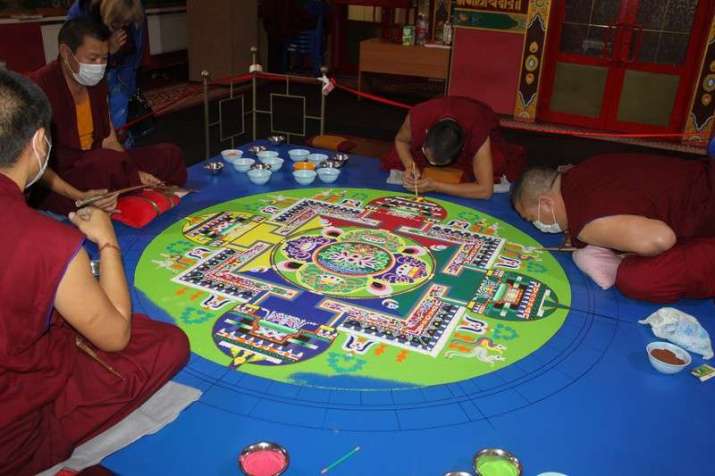
SOFIA—Monks from Drepung Gomang Monastic University in India have created a sand mandala of the bodhisattva of wisdom Manjushri (Tib: Jampalyang) in the central khurul (temple) of Kalmykia, the Golden Abode of Shakyamuni Buddha, in Elista, capital of the Republic of Kalmykia. The mandala, which took seven days to create, is on public display from 24–31 October.
In Vajrayana Buddhism the mandala (Tib: kyl khor) is regarded as a symbol of the universe and the celestial abode of a deity. Sand mandalas (Tib: dul tson kyil khor) are used as meditation aids. It is believed that the Manjushri mandalaembodies the transcendental wisdom (Tib: sherab) of the bodhisattva, liberating the mind from negative conceptions, helping to develop intelligence, and facilitating education and the spiritual journey.
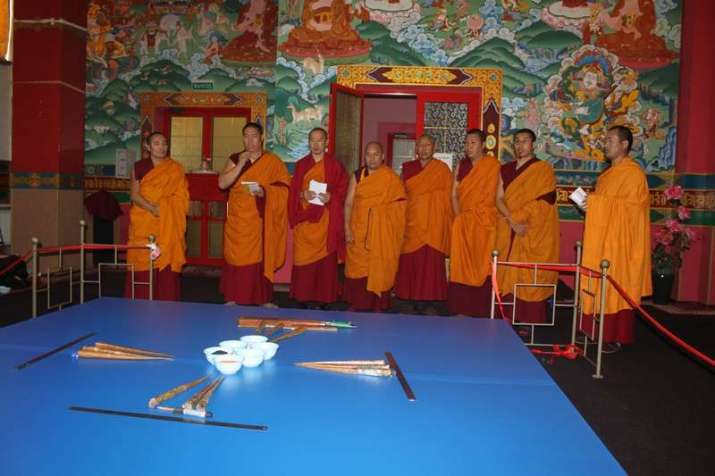
For eight days, the Kalmyk people will have the opportunity to contemplate the Manjushri mandala, constructed in the prayer hall of the central khurul. They can circumambulate (Tib:kora) the mandala and make offerings to the sacred diagram to accumulate merit (Tib:sonam).
The monks from Drepung Gomang Monastic University, who are visiting Kalmykia from 9 October–1 November, have programs in Lagan (10–16 October), Elista (18 October–1 November), and Malye Derbety (25–31 October). The monastic delegation is headed by Lobsang Yarpel Rinpoche, a highly qualified teacher and specialist in Buddhist philosophy. The other members of the delegation are Zopa Gyatso, Thupten Zopa, Kelsang Tsering, Drugtse Gyal, and Lobsang Tenzin, all of them experts in sutra and tantra, and masters of rituals. The monks are accompanied by the Tibetan doctor Penpa Tsering, who gives consultations and lectures about Tibetan medicine.
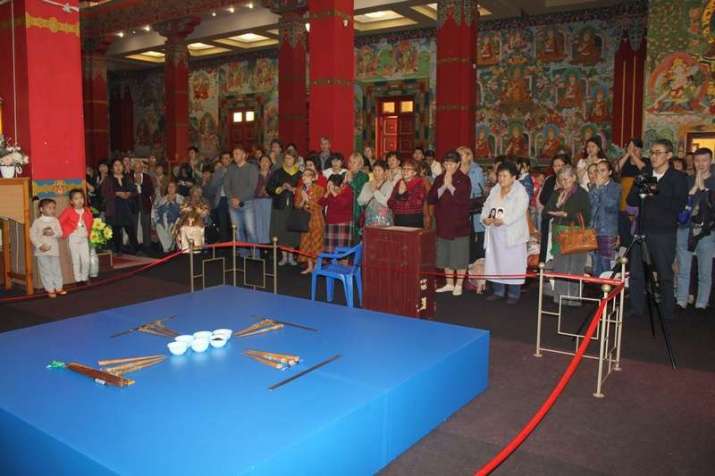
The monks began their visit to the region at the beginning of September, and participated in the Days of the Buddhist Culture of Tibet, in Moscow. They also visited Kazan, the Republic of Tuva, and the Astrakhan Region. Their Russian program is organized by the centralkhurul, the Golden Abode of Shakyamuni Buddha, and the Drepung Gomang Center Fund, with the support of the Save Tibet Fund in Moscow.
Before creating the Manjushri mandala in Elista, the monks created another mandala in the temple of Lagan, the second-biggest town in Kalmykia. The mandala at the Lagansky khurul depicted the abode of Hayagriva (Tib: Tamdrin), a wrathful manifestation of the bodhisattva Avalokiteshvara, who symbolizes enlightened speech, usually depicted in red with a horse’s head protruding from his crown. The monks’ program in Lagan also included lectures, and several ritual and prayer ceremonies.
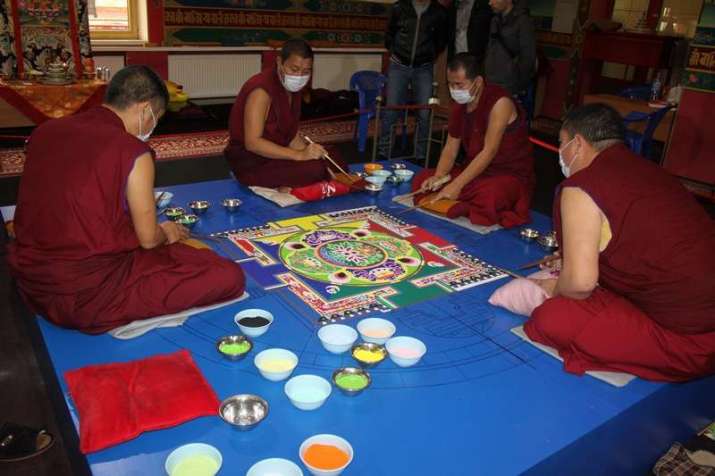
After building the Manjushri mandala, the monks traveled to Malye Derbety, a rural locality and the administrative center of Maloderbetovsky District in the Russian republic. At the local khurul of Malye Derbety, Ganden Dargeling, the monks are constructing mandala of Avalokiteshvara (Tib: Chenrezig), the bodhisattva of compassion.
The Avalokiteshvara mandala will be destroyed on 31 October, on one of the four major Buddhist holidays—the Festival of the Descent from Heaven (Tib: Lha Bab Duchen). On 1 November, the monks will return to Elista for the ritual destruction of the Manjushri mandala, distributing the blessed sand to the devotees present.
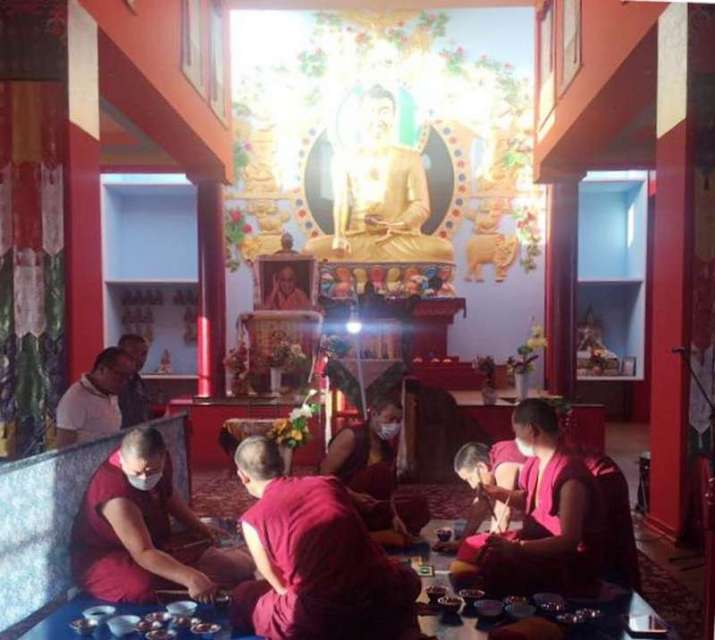
The creation of a sand mandala traditionally includes several steps: purification of the space, drawing of the lines, invocation of the deities, coloring of the mandala, and the ritual destruction. The ceremonies, chanting, meditations, and creative activities performed before, during, and after are all equally important, but the culmination of this sacred process is the destruction of the mandala—a metaphor for the impermanence of life and a means of releasing its blessing power.
Drepung Gomang Monastic University is the oldest of the seven colleges of Drepung Monastery—the largest monastery in Tibet, founded in 1416 by Jamyang Choje Tashi Palden (1379–1449), a disciple of the founder of the Gelug school, Je Tsongkhapa (1357–1419). After 1959, Drepung Gomang Monastery was re-established in southern India and currently accommodates some 1,850 monks.
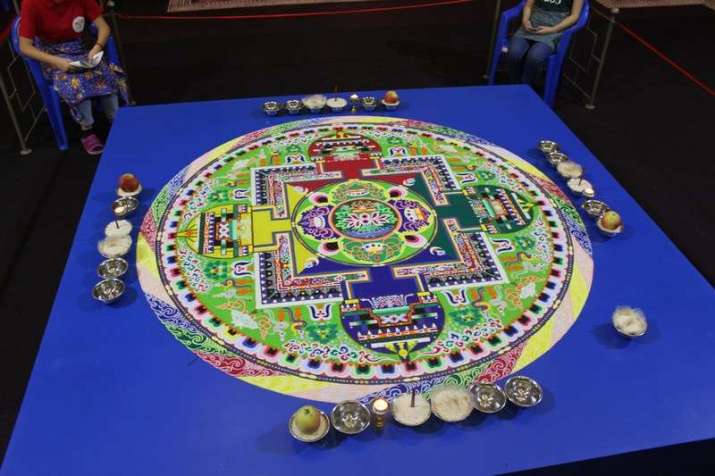
See more
В Калмыкии начался многодневный визит официальной делегации монастыря Дрепунг Гоманг (Золотая обитель Будды Шакьямуни)
В Элисте возведена мандала Манджушри – Будды знания и мудрости. Созерцать ее можно в течение восьми дней (Золотая обитель Будды Шакьямуни)














